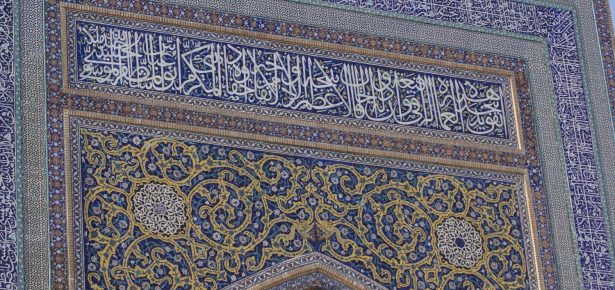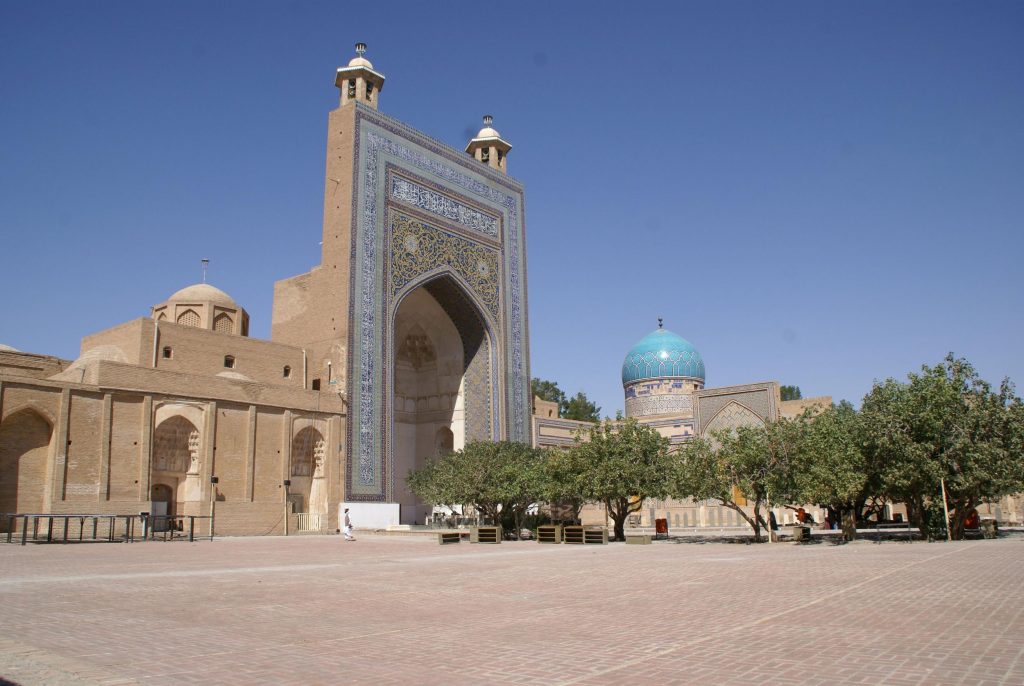
The shrine of Shaykh al-Islam Ahmad of Jam has been in existence since the saint’s death in 536 AH/1141 AD. The first major construction project at Jam, however, was not until 633/1236, when an unknown benefactor funded the ‘dome-chamber’ (gunbad) located behind the portal arch (iwan). Given that this work was performed about fifteen years after the Mongols invaded Iran, there is the suspicion that the patron was an ‘infidel’ Mongol, or a Muslim employed by the Mongols.
Since the erection of the gunbad, patrons representing Iran’s overlords—the Mongol Ilkhanids (r. 1254–1335), the (Sunni) Timurids (1381–1506), and the (Shiʿi) Safavids (1501–1722)—have sponsored seminaries, Sufi hospices, mosques, or decorative work. Prominent donors have included the Turkic conqueror, Tamerlane (d. 1405), and Iran’s celebrated Shiʿi ruler, Shah ʿAbbas the Great (d. 1629). The architectural and artistic ensemble at Turbat-i Jam is bewildering. Architectural styles and artistic flourished manifest at Jam have found their way to other regions in Iran, India, Istanbul, and Central Asia.

One of the decorative touches at Jam reflects Sunni and Shiʿa comity at a delicate moment in Iran’s political and religious histories. Iran’s journey from majority Sunni to majority Shiʿa began in 1501 when the newly-crowned Shah of Iran, Ismaʿil I (r. 1501–24), proclaimed Shiʿism would henceforth be Iran’s official confession. The decorative work of interest is reflected in the portal arch (iwan), which looms 88 ft./26.8 m over Ahmad-i Jam’s tomb (Figure 1). The iwan’s construction was completed around 763/1361-62. The iwan fell into disrepair in the following 250 years, primarily because Shiʿism proliferated; a number of devotees of Ahmad and patrons of his shrine shifted allegiances to Shiʿism, or migrated to Sunni lands like Ottoman Anatolia and Mughal India. Descendants of Ahmad-i Jam were welcomed by Mughal emperor, Humayun (d. 1556), and his son, Jalal al-Din Muhammad Akbar (d. 1605), who also were descendants of the saint.
An iwan is a prominent feature of Islamic architectures of the Persianate east. The eminent French scholar, André Godard, explains: “in contrast to the tradition in the west where the [church] dome was the dominant feature, the immense and magnificent ivan … proclaims from afar the funerary mosques and the musalla mosques of Khurasan.” Indeed, the iwan is a beacon for travelers and pilgrims.
Shah ʿAbbas (r. 1587–1629) was known for acts of bigotry, although targets of vitriol were not necessarily Sunnis. In 1022/1613–14, he sponsored decorations to the iwan. His generosity is recognized in the inscription (in elegant thuluth script) along the top of the iwan. It identifies the patron and prays ‘May God perpetuate his kingdom’ (khallada Allah mulkahu). At the bottom of the iwan are verses (ayat) from Surat al-Mulk (‘the dominion’; Qurʾan, chap. 67). Refurbishing and decorating the iwan demanded special materials and skilled craftsmen. The benefaction will have cost the crown a hefty sum.
Why did Shah ʿAbbas see fit to honor a Sunni saint and Sufi shrine? An answer has not emerged from the historical record.
Legends abound at Turbat-i Jam as to why a dogmatic Shiʿi shah sponsored work at a Sunni shrine. A popular story is that it was a posthumous miracle by Ahmad-i Jam, who had convinced the Shah that the saint (i.e., Ahmad) entombed at Jam was Shiʿi!
Latest Comments
Have your say!